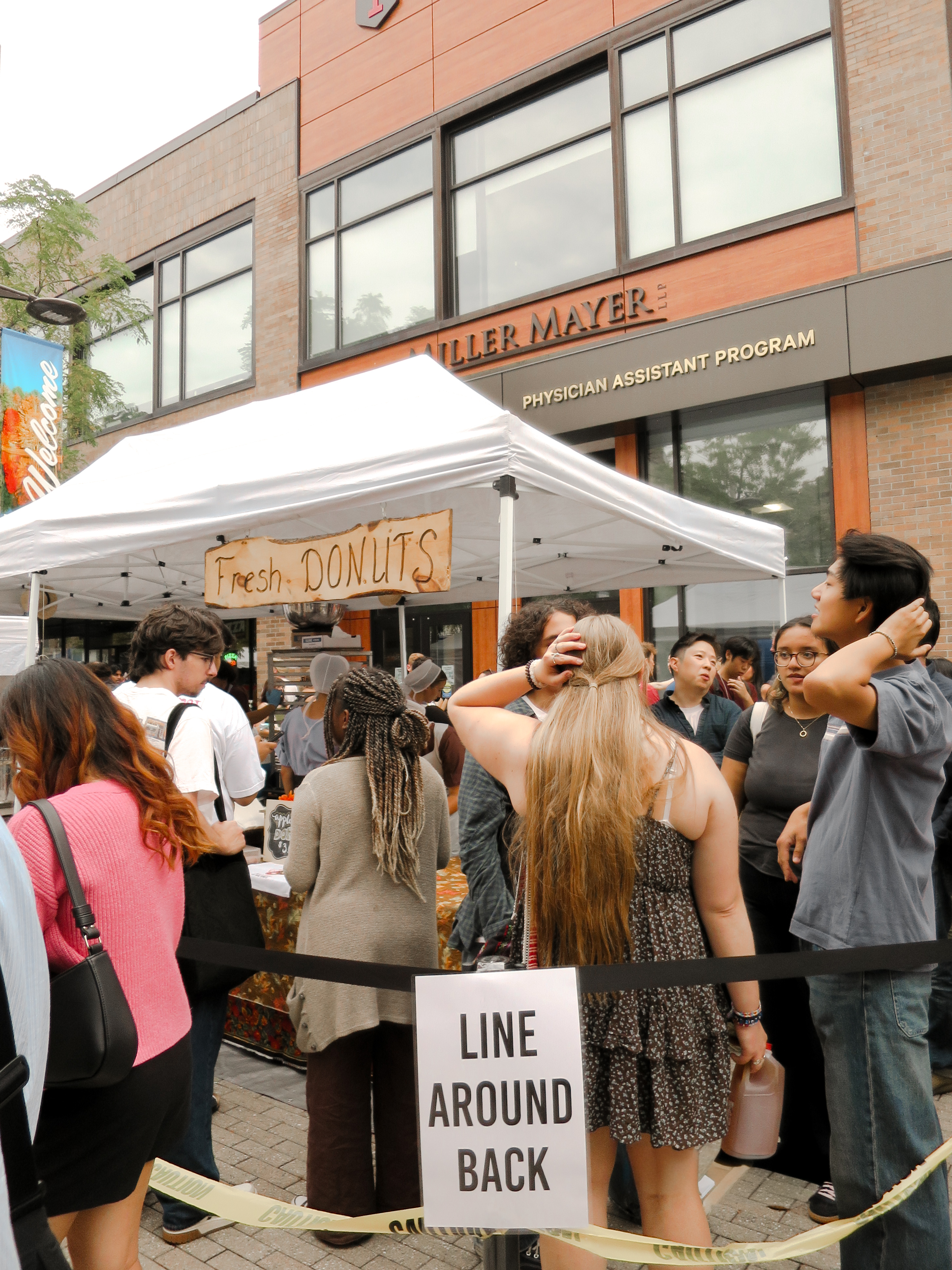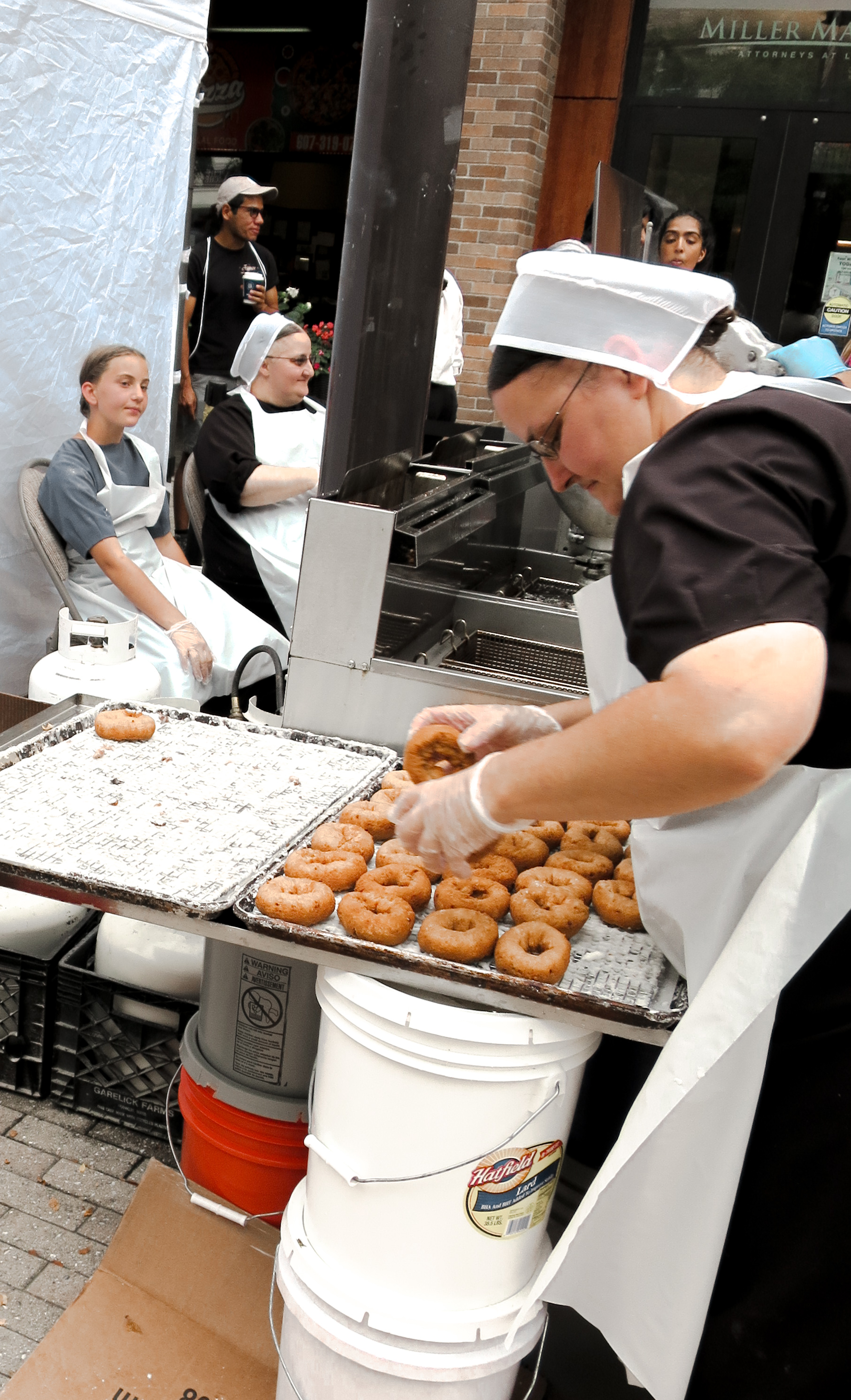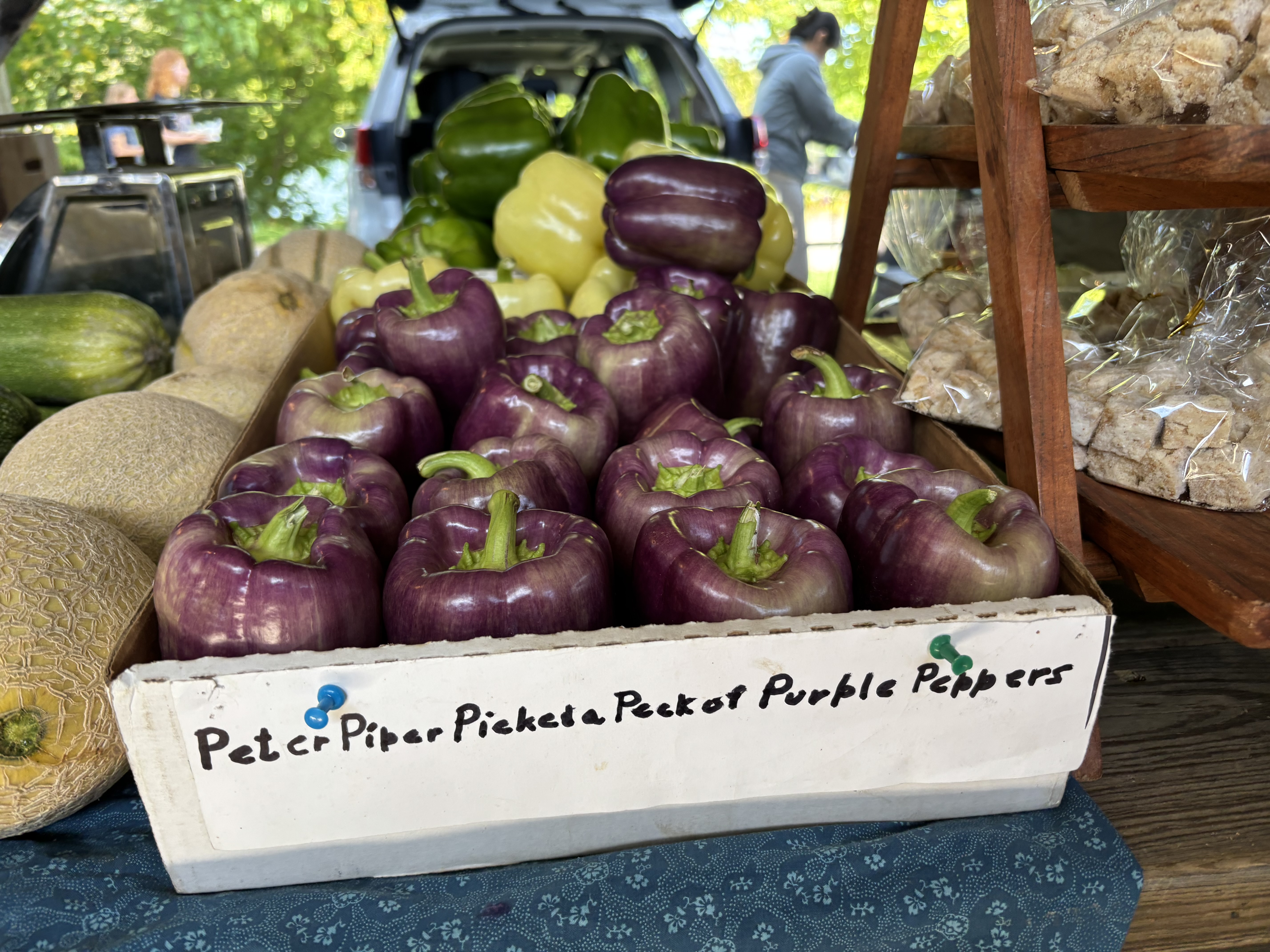Across the walkway, I could see the Amish hard at work. An older woman in a black dress and white bonnet wearing thin-rimmed glasses manned the cashbox. A younger boy with a mess of curly hair near the back of the tent sat observing the crowd while a tray of doughnuts lay in front of him ready to be glazed. Whirring sounds from the mixing of batter floated through the air as two younger girls stood in front of a messy, large metal bowl.

CREDIT: NOOR SATTAR / COLLEGETOWN
Watching the coordination and rhythm of the stand, I wondered how much effort went into an ordeal like this. I approached the middle-aged man at the fryer who introduced himself as Levi. We stepped to the side of the tent, and he answered my questions with his tools still in hand.
Levi’s group had been selling the famed doughnuts at Apple Fest since 2017, after hearing about the festival through friends. Over the course of the weekend—the only time of year they sold the treats—their stand sold about ten thousand doughnuts. I recalled a small chalkboard at the register announcing “$3.00 each” or $35 a dozen, and I couldn’t help but perform a quick calculation in my head. Simplicity, apparently, could be quite lucrative.
Levi explained how their preparation for Apple Fest had begun several weeks in advance, placing orders for all the appropriate materials. When asked about how their ingredients were sourced, he succinctly replied that they used a mix. I glanced over at the white and red layered sacks of “flour,” resting atop a wooden pallet with “Dawn” written in big black letters on each one. A later search would yield that the bags actually contained apple crisp cake doughnut mix from Dawn Foods, a (family-owned) company with a global reach in bakery manufacturing and ingredient distribution.

CREDIT: NOOR SATTAR / COLLEGETOWN
Levi told me they arrived at the festival early each morning from Romulus, a small town in Seneca County thirty miles north of Ithaca. The Amish settlement of Romulus is part of a community of Amish and Mennonite people in the Finger Lakes region.
Sometimes called “Plain People,” Amish and Mennonite societies were founded on Anabaptist religious principles, originating in the 16th Century Protestant Reformation of Europe. “Anabaptism” means to be baptized by choice during adulthood instead of during a child’s infancy. Although the main divide between the Amish and Mennonite has to do with a historical separation, this difference manifests itself in practice, with the Amish being more traditionalist as opposed to the Mennonites — who are more integrated with modern society.
Following policies of state-mandated religion in Europe, Amish and Mennonite groups began to migrate to the New World from Switzerland and Germany in the late 18th Century. They primarily settled in areas surrounding Lancaster, Pennsylvania—what has now informally become their cultural hub.
Most of the settlements in the Finger Lakes region are made up of migrants from Lancaster County. In recent years, many Amish families have begun leaving Pennsylvania in search of cheaper, more viable farmland. Driven out in part by Lancaster County’s tourism industry, the rural areas in Yates and Seneca counties offer a quieter, more affordable alternative residence.
The move also helps them practice their beliefs of separating from modern society, including a simple lifestyle, plain manner of dressing, and most popularly—a rejection of modern technology.
Beckoning towards a 20V DeWalt mixer/drill, Levi described how the Amish did not use electricity “off the line.” The battery-operated mixer would aid in the doughnut-making operation while still adhering to their way of life. These limited uses of technology vary across communities, with the vast majority prohibiting access to the public power grid.
Professor George Frantz of Cornell’s College of Architecture, Art and Planning has worked with the Amish and Mennonite for forty years, and was enthusiastic to provide more insight into how Amish community values are situated in a modern context. A native of Pennsylvania, Frantz had grown up surrounded by large populations of Amish and Mennonite. His role as a professional practitioner in urban and regional planning combined with knowledge of Plain communities has made him an advisor for local governments on following zoning regulations while accommodating Amish and Mennonite needs.
Frantz underscored how important it was for him to have a deep understanding of their history, religion, and culture to do his job. Despite decades of knowledge, Frantz was not familiar with the famous doughnuts I thought were known to all on campus.
“They’re brought up in this very strong, nurturing community,” he explained, “that is far more attractive [to them] than this world.” Frantz described how the Amish fought against social security taxes, because “they have their own internal retirement system,” and “the elder son is responsible for the care of the parents.” According to the professor, three things matter most for the Amish: community, work, and prayer. Frantz’s detailed answers were in stark contrast to Levi’s concise ones, underlining the Amish inclination towards reserve and privacy.
At the same time, he emphasized that despite their strong internal communal ties and religious beliefs, they are not an insular group. “Instead of TV, they read. So they have a very well-based knowledge of us.”
This proved true in my conversation with Ezra Peachy, an Amish farmer from Ovid, a town five miles from Romulus. Peachy sold fresh produce from his farm at the Ithaca Farmers Market. Following a remark I made on a clever label for his peppers, Peachy looked at me closely before asking if I was from India.

CREDIT: ALEENA NAEEM / COLLEGETOWN
Surprised, I explained that I was from Pakistan, right across the border from India. In response, Peachy smiled warmly and told me he grows apricot trees from Hunza Valley, Pakistan. He added how his father had read a book on Pakistan and that he was somewhat knowledgeable about the country. It struck me as oddly delightful: an Amish farmer in upstate New York tending a fruit native to my home country halfway across the world.
Peachy’s quiet familiarity with my home country revealed an understated curiosity about the world beyond Seneca County. Frantz, too, described moments where the boundaries between Amish life and the outside world blur in unexpected ways.
Since the Amish are Anabaptists, children and teenagers are technically exempt from religious decrees until they formally join the church. Frantz described how in large Amish communities, it was typical to find a line of cars—all black to reflect Amish simplicity—in the back streets of the local villages which “disappear Friday night.”
He excitedly told me, “That’s when they’re out on the town partying, drinking, having a great time with their friends.” He went on to say that it wasn’t uncommon to see a father riding in the backseat of a car driven by his son, a way to circumvent the restrictions on technological use. Frantz chortled, recalling once seeing a semi-drunk teenage Amish girl following behind a “big biker,” with a beard, long hair, and a Hell’s Angels motif. “The word is always, ‘Be discreet,’” Frantz said, grinning.
As I sat across from Levi’s doughnuts, a line had begun to form. Two college girls posed in front of the stand for a picture, doughnuts proudly displayed in hand as the hum of conversation and laughter grew louder. I noticed a straw hat resting in the tent’s rafters—a quiet witness to the bustle of people below. Despite its stillness, somehow it still coalesced into the surrounding change.

CREDIT: NOOR SATTAR / COLLEGETOWN
.jpg)